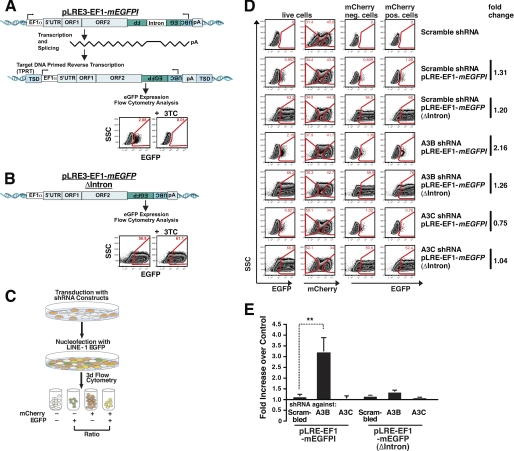FIGURE 2.
shRNA knockdown of A3B mRNA in HeLa cells increases L1 retrotransposition. A, an overview of the pLRE3-EF1-mEGFPI L1 retrotransposition assay. LRE3 is tagged with an EGFP indicator retrotransposition cassette (mEGFPI) containing an antisense copy of the EGFP gene disrupted by intron 2 of the γ-GLOBIN gene in the sense orientation. The reporter gene is bordered by a heterologous promoter (UBC) and a poly(A) signal. An EF1α promoter drives engineered L1 expression (in addition to the L1 5′ UTR internal promoter). Protein expression from the reporter gene driven by the UBC promoter should only occur after reverse transcription and integration of the spliced reporter sequence into the genomic DNA (7). For simplicity, the schematic shows an engineered full-length L1 insertion, although most insertions are 5′ truncated (2). The dependence of retrotransposition (EGFP expression) in reverse transcription is demonstrated by a 99.5% decrease of EGFP expression upon treatment of transfected cells with the reverse transcriptase inhibitor 3TC (100 μm) during the L1 retrotransposition assay. B, scheme of the pLRE3-EF1-mEGFP(Δintron) control. The control plasmid is identical to the L1 reporter construct except that it lacks an intron in mEGFPI, allowing EGFP expression in the absence of splicing, reverse transcription, and integration. pLRE3-EF1-mEGFP(Δintron) thus serves as a positive control for transfection efficiency as well as plasmid stability. C, schematic depiction of the retrotransposition assay performed with HeLa cells transduced with lentiviruses expressing pSicoR-MS1 mCherry shRNA targeting different A3 mRNAs. After culturing for at least 6 days, transduced cells were transfected with pLRE3-EF1-mEGFPI or pLRE3-EF1-mEGFPI(Δintron) and analyzed 3 days later by flow cytometry. D, flow cytometry plots of cells transduced with lentiviruses carrying pSicoR-MS1 mCherry scrambled shRNA or shRNA against A3B or A3C are shown as an example of the gating strategy used. In each sample, ∼3 × 104 cells were analyzed. Cells were first gated against an empty channel (Alexa 405) (not shown) to eliminate background from autofluorescent cells and increase sensitivity. E, analysis of L1 retrotransposition efficiency in HeLa cells transduced with lentiviruses carrying pSicoR-MS1 mCherry scrambled shRNA or shRNA against different A3 mRNAs. To determine the effect of shRNA-mediated knockdown on retrotransposition, the ratios of EGFP-positive transduced cells (EGFP+/mCherry+) and EGFP positive nontransduced cells (EGFP+/mCherry−) were calculated. Each bar in the diagram averaged six (pLRE3-EF1-mEGFPI) or four (EF1-mEGFPI(Δintron)) independent experiments using the strategy described in D. Values are mean ± S.E. **, p ≤ 0.01.

